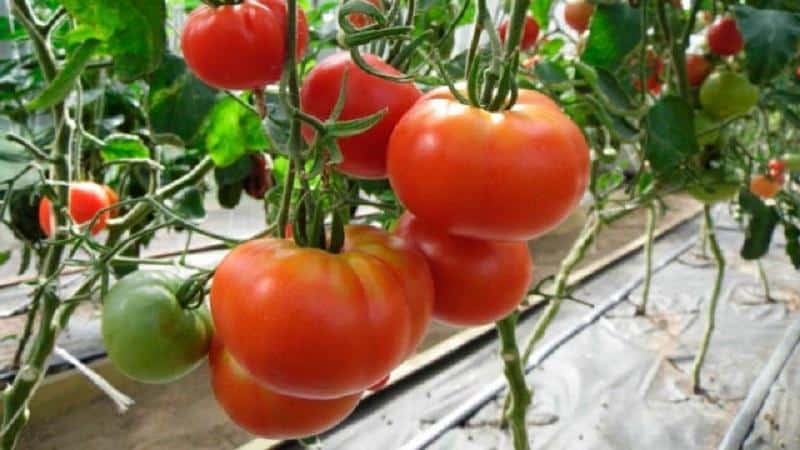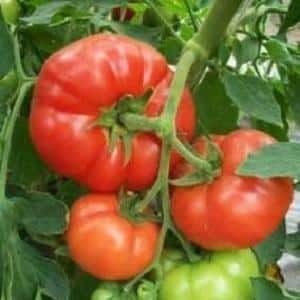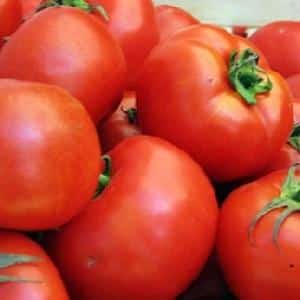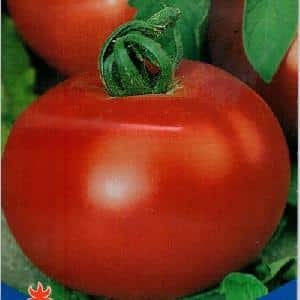Large and easy-to-care tomato “Family f1”: we grow it ourselves, avoiding mistakes
Tomatoes are widespread on all continents except Antarctica. From a scientific point of view, a tomato is a berry, but it is generally considered to be a vegetable. To increase productivity and improve taste, breeders develop varieties called hybrids.
It is believed that they are more resistant to disease and less demanding to care for. One of the representatives of such tomatoes is called Family. We will consider the detailed characteristics and description of the variety below.
Description of the variety
The variety is suitable for growing in greenhouses and open ground. Bushes determinant, i.e. limited in growth, which greatly facilitates the care of the crop. Tomato Family F1 is an early ripening variety, the first harvest is harvested 105-115 days from planting.
Over a short period of ripening, the risk of infection is significantly reduced, which is good for yield.
Distinctive features
The bushes are compact, maximum height is about 100-110 cm. The leaves look like potato leaves and have the same dark green color. The stem and root system are developed and powerful. Inflorescences are racemose, small. Each cluster produces about 5 large red tomatoes.
Characteristics of tomatoes and yield
The weight of one tomato is about 200 g. The color is rich, the flesh is juicy and fleshy. The hybrid's peel is dense, which allows the vegetables to be stored for a long time without cracking. There are many seed chambers. The taste is sweet and sour with a classic aroma.
With quality care, one bush produces from 4 to 7 kg of ripe and tasty vegetables. In a greenhouse with 1 sq. m harvest about 19 kg.
Interesting! In the Middle Ages, a scientist named John Gerard said in his writings that tomatoes and its leaves were poisonous. Gerard categorically forbade eating vegetables. The scientist’s opinion was so significant for the British that until the 18th century people did not eat tomatoes. And he himself grew the crop in his garden only for scientific purposes. It is noteworthy that at the same time, tomatoes were eaten in Italy and Portugal, which John Gerard knew about.

How to grow seedlings
To get a good harvest, gardeners recommend planting tomatoes in seedlings. Although this takes more time and effort, it will be easier for the plant to take root in the garden plot. Especially when it comes to regions with unpredictable climatic conditions.
Seed preparation
You can purchase Family Tomato seeds at any gardening store or order by mail. On the bags, the manufacturer indicates recommendations for planting and growing.
First, take a look seeds for defects. If individual specimens are of unusual color or shape, do not plant them. Be sure to disinfect the rest of the material.
They do this in several ways:
- lay it out in the sun for 5-7 days, for example, on a balcony or on a bench near the house;
- soak for 24 hours in a solution of potassium permanganate, for convenience, first placing the seeds in a fabric bag;
- Soak overnight in aloe juice.
Disinfection will destroy dangerous microbes on the surface of the seeds, which will subsequently ensure rapid germination and a good harvest. Afterwards it is necessary to germinate the seed material.Take a damp cotton pad, place the seeds in it and put the disc in a plastic bag or plate. In this form, the seeds are stored for 4-7 days. Germination helps the plant develop immunity to diseases and parasites.
Container and soil
Most gardeners use ready-made soil mixtures for seedlings. Firstly, they are pre-disinfected by the manufacturer and do not contain pathogens. Secondly, such soil is enriched with vitamins and minerals necessary for the plant. Purchasing land will not be difficult; on average, 10 liters costs about 150 rubles.
Plant seedlings in any clean and dry container - cardboard milk cartons, plastic cups, flower pots, and so on. Especially recently, peat pots or tablets have become popular. They are made from environmentally friendly materials, which means they are absolutely safe for both plants and humans. Such containers are affordable and easy to use. Plus, peat containers retain moisture well, which is important for a hybrid.
Landing
Prepare seedlings 50 days before planting in the garden. To do this, pour the soil into a container, make grooves 2 cm deep in it. The distance between the grooves should be at least 15 cm. Place the seeds in the holes and sprinkle the soil on top. Don't forget to water the seedlings with warm water. To speed up growth, stretch the film or place glass on top.
Growing and care
 The optimal temperature for growing seedlings is about 22 degrees; as soon as the first shoots appear, we recommend reducing it to 18. This will speed up the formation of flower clusters.
The optimal temperature for growing seedlings is about 22 degrees; as soon as the first shoots appear, we recommend reducing it to 18. This will speed up the formation of flower clusters.
The best place for growing is a bright window. However, make sure there are no drafts. As soon as half of the seeds germinate, remove the film.
Water the seedlings only with warm filtered water. For ease of watering, use a pipette or syringe. After 5 days, as soon as all the seeds hatch, organize feeding with calcium nitrate.
In the future, feed the tomatoes every 10 days. To do this, use an ash solution, liquid bird droppings, or superphosphate.
Important! An effective remedy for increasing plant immunity is Bordeaux mixture. You can buy a ready-made mixture in the store or make it yourself. Spraying from a spray bottle rids seedlings and soil of harmful microorganisms and improves the development of the root system.
How to grow tomatoes
To transplant seedlings into open ground, stable weather and above-zero temperatures are required. After planting the seedlings in the beds, it is also recommended to cover them with film for the first time.
Landing
Before planting, be sure to carry out procedures to disinfect the soil. The preparations “Bactofit” and “Planzir” are excellent for this. Apply the products to the top layer of soil. Also, do not forget to dig up the beds and remove all debris and old plants from them. When you prepare the ground, place the sprouts in it at a distance of 50 cm from each other. Be careful not to damage the still immature and weak stems.
For 1 sq. m, plant no more than three bushes of the Family variety. Dense plantings only harm the bushes and reduce productivity. For better development, immediately after planting, water the bushes with warm water. Cut off the lower leaves so that they do not take away nutrition.
Care
First of all, the bushes need shaping. As a rule, Family is formed into 2 stems, removing all side shoots and leaving 3-4 leaves. You should not remove stepsons with your bare hands; wear gloves and use garden shears.
Carry out pinching every 5-7 days. Also remove growing leaves during the entire ripening period. Ideally, you should end up with a bush on which there is nothing except trusses with tomatoes.
The Family variety is notable for its large and heavy tomatoes, which means that it is necessary to tie the bushes to a support. Wooden stakes and twine are usually used as support. Place a peg at a distance of 30-50 cm near each bush. As soon as the tomatoes begin to form, tie the bush to a support. If this is not done, the brushes will break under the weight of the tomatoes.
Don't forget to water your tomato beds promptly. It is best to do this in the early morning or evening. Try to ensure that water gets only under the root of the plant, bypassing the stem, leaves and fruits. Excessive humidity leads to cracking of the fruit. For 1 bush, use no more than 0.5 liters of water.
An important stage of cultivation - feeding. Ideally, gardeners recommend alternating mineral and organic fertilizers.
The most effective fertilizers are recognized:
- ash;
- nettle infusion;
- yeast solution;
- manure and droppings;
- aloe juice;
- "Kornevin";
- "Epin";
- "Solution."
Deposit funds every 10-15 days. Pay special attention to fertilizers at the stage of flowering and fruiting of the bush. If you use chemicals, follow the recommendations and dosage recommended by the manufacturer.
Features of cultivation and possible difficulties
 Often, if the rules of planting and care are followed, gardeners observe that the bushes are damaged by infections and fungi. The reason for this may be insufficient soil tillage before sowing.
Often, if the rules of planting and care are followed, gardeners observe that the bushes are damaged by infections and fungi. The reason for this may be insufficient soil tillage before sowing.
To avoid this, gardeners advise:
- divide the garden into narrow beds of 2 m each;
- observe crop rotation and do not sow tomatoes in the same place for more than three years;
- do not plant the hybrid after potatoes or zucchini;
- Carefully remove the tops and burn them away from the beds.
If the area is small, it is better not to use chemicals, but to give preference to biological disinfectants. The solutions “Baikal-EM 1” and “Baikal-EM 5” are especially effective.
Diseases and pests
Most often gardeners complain about late blight – fungal infection. This enemy of tomatoes attacks the crop year after year and destroys the crop. Signs of late blight are brown spots on the leaves and a white coating. The reasons lie in improper care, high humidity, and an excess of nitrogen-containing fertilizers. For prevention, spraying with a soap solution or a solution based on whey is used.
Tomatoes are also affected by root rot, blackleg and powdery mildew. Diseases affect different parts of the plant, disrupt the body’s metabolism and take away vitamins and minerals from the bushes. A solution of copper sulfate helps get rid of them.
Of the insects, the hybrid is most often attacked by aphids and whiteflies. Outwardly similar to each other, flying insects land in flocks on castings and cover them with white cobwebs. They are perfectly camouflaged, making it difficult to notice pests. For prevention, it is recommended to use wood ash.
The nuances of growing in open ground and greenhouses
When growing Family outdoors, pay special attention to the formation and staking of the bush. Pegs and ropes must be disinfected, since there may also be pathogens on the surface.
Although the variety is determinate, do not forget to pinch the tops. This will help the bushes get more sunlight, which means more tasty tomatoes.
If tomatoes are growing in a greenhouse, ventilate it daily by opening the windows and doors. The building has a special microclimate and high humidity. The optimal temperature should be no more than 18 degrees, otherwise the risk of contracting diseases increases. It is advisable that the greenhouse be located away from underground groundwater.
Harvesting and application
The yield of the variety is friendly, so tomatoes are harvested immediately after ripening. It is better to pick along with the stalk so that the vegetable can be stored longer. If you pick a green tomato, it will ripen quietly on the windowsill or balcony. In general, the variety stores well, especially if you place the crop in a dark, dry and ventilated place.
The variety is used in cooking. Used fresh and after heat treatment. Family demonstrates excellent quality snacks, salads, side dishes, soups. It also makes excellent adjika and tomato ketchup.
Advantages and disadvantages
The advantages of the Family variety are its marketable appearance, sweet taste and juicy pulp. In addition, it is grown in any climatic conditions and is resistant to diseases and insects. Family is rich in vitamins, so dishes with it are not only tasty, but also healthy. The only disadvantage is the need for mandatory bush formation.
Farmer reviews
Gardeners speak mostly positively about the Family variety.
 Lyudmila, Kazan: “I’ve been growing this variety for several years now. I like its taste and appearance. It also produces an excellent harvest in our weather conditions. Last year I collected about 6 kg from 1 bush.”
Lyudmila, Kazan: “I’ve been growing this variety for several years now. I like its taste and appearance. It also produces an excellent harvest in our weather conditions. Last year I collected about 6 kg from 1 bush.”
Maria, Voronezh region: “I only love hybrids, because they get sick many times less. I planted a family variety for the first time, overall the variety is not bad. The ovary is good, the tomatoes are large. The taste is good."
Elena, Ekaterinburg: “I expected much more from the Family variety. The manufacturer promised large tomatoes, but my maximum weight for one is only 140 g. I grew it according to all the rules, I don’t know what’s wrong.”
Conclusion
Hybrid Family is an excellent variety for universal use. It shows good results both in the south of the country and in the northern regions. Tomatoes are rich in vitamins, acids and beneficial macroelements.
The vegetable is perfect for children's and dietary nutrition. The Family variety makes delicious first and second courses; the tomato is good baked and canned.